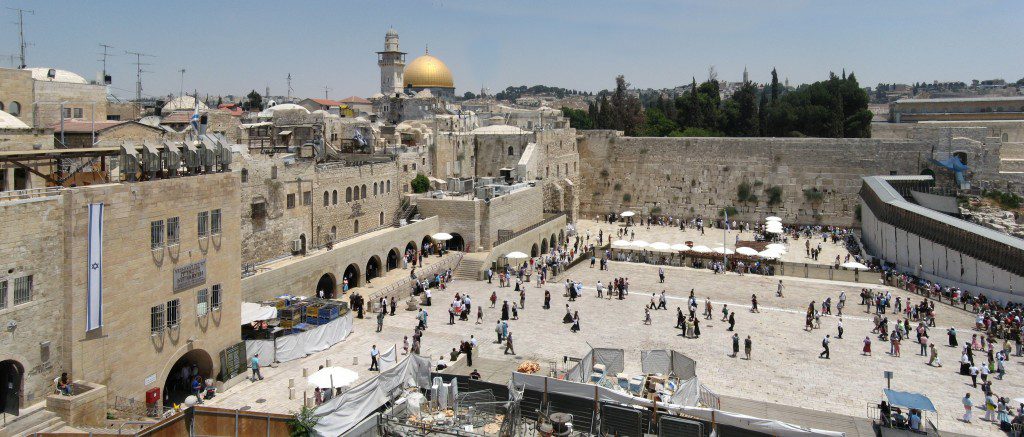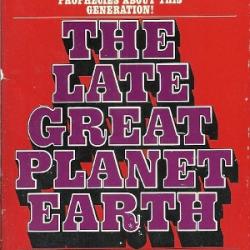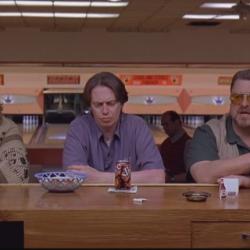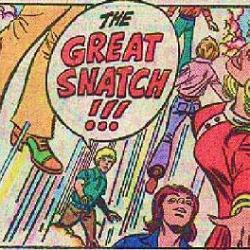Left Behind II: Tribulation Force, Part 8
Donald W. Thompson gave me nightmares.
I grew up in the American evangelical Christian subculture in the 1970s and 1980s, so it’s impossible for me to watch a movie like Left Behind II: Tribulation Force without thinking of Thompson’s earlier End Times movies. Those movies scared the Hell out of me, which is exactly the effect Thompson wanted.
If you’ve ever seen A Thief in the Night or its sequels, then you know they weren’t good movies. The dialogue was unnatural and the cast of nonprofessional actors had little idea of what they were doing. But Thompson made the most of his very limited resources and managed to create some haunting images that stick with you after better movies are forgotten.
The story was based on Hal Lindsey’s phenomenally popular books of “Bible prophecy,” so it didn’t make a whole lot of sense. But the movies were compelling because Thompson had a central theme, a driving concern that shaped every scene in his movies: Get saved now, before it’s too late, or this will happen to you.
That’s a crudely and cruelly manipulative message. It’s wrong-headed, theologically misguided and ethically dubious to think that people can or should be scared into Heaven. But my point here is that Thompson desperately wanted people to go to Heaven and not to Hell. As awful as his pursuit of that agenda was, it was still, at a basic level, an expression of his concern for others. He believed they needed saving and he urgently wanted them to get saved.
One of the most striking things to me about the first two books of the Left Behind series was the lack of such urgent concern from Tim LaHaye and Jerry Jenkins. This is a huge departure from Lindsey and Thompson and all the earlier popularizers of premillennial dispensationalist “Bible prophecy.” The driving theme of Left Behind and Tribulation Force is not ” Get saved now, before it’s too late, or this will happen to you,” but rather, “We’re saved, and those people didn’t listen to us, so they deserve this to happen to them.”
The section of Left Behind II: Tribulation Force that we’re looking at this week includes some painfully awkward, clumsily didactic scenes presenting the filmmakers approximation of the Plan of Salvation and demonstrating what they believe to be the necessary response to that message. This is all pretty excruciating to watch, but it’s also another illustration of my main evaluation of this movie: It’s awful, but it’s much better than the book. The explicit evangelism of the movie may be bumbling, but its infinitely preferable to the triumphalism of the books’ abominable fancy.
Buck Williams is back in his hotel room, getting ready for his big meeting with the Two Witnesses. He looks at the photo-booth pictures he took with Chloe. The photo in the shirt pocket is standard movie-shorthand for reminding viewers that the hero is thinking of loved ones back home. But just in case viewers don’t understand that shorthand, director Bill Corcoran underlines the point in the next scene by having Buck talk to Chloe on the phone, retelling us what we’d just been shown. But at least it’s a photo in Buck’s shirt pocket and not a cookie.
Buck’s plan involves getting Rabbi Tsion Ben-Judah to the magicians at the Western Wall, which is cordoned off by armed soldiers.
“I still don’t know how we’re going to get to the Wailing Wall,” he says to Rayford.
“God got us this far, he’ll take us the rest of the way,” Rayford says.
That’s the plan: Jesus Magic. Sometimes you just have to step out on faith and depend on God to provide a miraculous solution, like, say, throwing yourself down from the pinnacle of the temple, for it is written, “He will command his angels … they will bear you up, so that you will not dash your foot against a stone.”
Our heroes are about to spring into action, carrying out their still-fuzzy-on-the-details plan. So first it’s time to pray.
“Let’s pray,” Cam-Cam says abruptly, and the scene that follows is awkward and unnatural. Cam-Cam is earnest and uncomfortably intimate. Brad Johnson seems unnerved and uncertain what to do with his hands. The scene is, in other words, a remarkably realistic portrayal that perfectly captures what this common expression of evangelical piety is like in real life.
“Amen,” Cam-Cam says at the end.
“Amen,” Johnson echoes, looking enormously relieved.
Back in the Chicago suburbs, the lawn of the New Hope Village Church is still a disgraceful mess. Inside the church, Chloe’s cell phone is ringing.
She’s back in the NHVC field hospital, which we see here for the first time in daylight. Now we can see the vaulted ceiling and the tall, arched windows, so it seems this is in the main sanctuary of the church — the same sanctuary in which Bruce conducted his revival meeting the other night. (We’ve seen the exterior of the building — it can’t have two sanctuaries.) This just makes no sense at all. Despite the constant siren-noises in the background and that initial martial-law scene in an alley, we still haven’t seen enough to believe that these people couldn’t be in a real hospital receiving proper care. But even if we buy that, then why, again, didn’t they set up this clinic in the now empty and unused local elementary school?
“I’m still going to the Wailing Wall,” Cam-Cam tells Chloe on the phone.
“Buck, you can’t,” she says, “the UN just announced that anyone who tries to approach is going to be shot on sight.”
She saw this announcement on TV. This very specific local warning was broadcast all over the world. You may think that strange — why would people in far-off continents need to be warned to stay away from a site in Jerusalem? But see what just happened? Here is a man in Jerusalem actively planning on approaching the wall, and how did he hear about this warning? He missed the televised announcement, but then he heard about it by telephone from someone in Illinois.

Cam-Cam meets up with the still-brainwashed rabbi and they head to the Western Wall.
Or, rather, they head to some shadowy alleyway guarded by a handful of nondescript soldiers, a place that looks nothing at all like the world-famous iconic site it’s supposed to be.
I appreciate the budgetary constraints of this project, but this unforgivable error isn’t a problem of too-small a budget or of the inability to film at the actual holy site. It’s a problem of a Western Wall set designed and filmed by people who have evidently never even seen a picture of the Western Wall.
Jerry Jenkins’ description of the area in the book is garbled and inaccurate, but it was still better than this. The filmmakers give us a not-quite-mappable collection of cramped, narrow alleyways — a scene that looks more like the catacombs beneath Jerusalem than like this part of the city itself.
Worst of all, after all the build-up about armed soldiers with orders to shoot on sight, the security on hand here is far less than the existing military checkpoints around the real site here in the real world.
The soldiers here are in nondescript uniforms with no easily visible insignias. I think, despite the lack of blue helmets, that they’re meant to be Nicolae’s soldiers in the UN/OWG/GC military. That underscores another departure from the book. Nicolae’s treaty between the OWG and the lone remaining sovereign state of Israel is a very important item in Tim LaHaye’s prophecy check list. In his scheme, that signing — the only piece of “Bible prophecy” directly fulfilled in Book 2 of the series — is what officially begins the seven-year Great Tribulation and the final countdown to the end of the universe. In this movie, though, it’s an afterthought — just an excuse to bring the lead characters to Jerusalem and the Two Witnesses. I suspect that’s another reason LaHaye wasn’t happy with this movie.
Rayford is here at the “Wailing Wall” too, sneaking past some potted plants as he approaches the guards. He sees Cam-Cam turned away by the soldiers and prays for the miracle that their plan requires to be successful.
“Give me strength, God,” Rayford says. And suddenly someone takes his hand. It’s “Angelic Woman” — the lovely white-clad lady he met earlier on the other side of the world, on the mean streets of Mount Prospect.
“May you walk in the faith of the Lord,” she says to him. And then she starts singing “Amazing Grace,” leading Rayford out of the alley, past what appears to be a makeshift shrine for victims of a bus accident, and directly toward the soldiers.
“Stop, stop immediately!” says one of the non-actor extras dressed as soldiers. But Rayford keeps walking toward them as they point their guns.
We’ve seen Johnson struggling throughout this movie to find some motivation that would allow him to make Rayford’s words and actions believable. His choice here seems to be that Rayford is sacrificing himself to provide a distraction that might enable Buck and the rabbi to sneak past the guards. He’ll die, but Buck will be able to get the rabbi to the Witnesses and thereby save the world. It’s just like Bruce Willis sacrificing his life to save Ben Affleck in Armageddon.
The blocking of the scene spoils that idea, though, since Rayford’s distraction is occurring in the same cramped little space in which Buck and the rabbi are also standing. But in any case no one gets shot because it turns out that Angelic Woman is working powerful Jesus Magic with her song and the soldiers are frozen in place, allowing Rayford, Buck and Ben-Judah to pass by unharmed and unseen.
No, none of this is in the book. And no, none of this makes even a tiny bit of sense. So let me just say this: If you ever have the occasion to visit the Western Wall, please do not sing “Amazing Grace” when you get there. Or any other Christian hymns. Singing Christian hymns at the holiest site in Judaism is incredibly disrespectful and rude. (And in real life it won’t make the soldiers there freeze in place, it will make them rush over to ask you to please stop singing.)
Buck and Ben-Judah walk another 50 feet to arrive at where the Two Witnesses are standing in front of a big wall. It still looks nothing like the actual wall, but at least it’s big.
As in the book, the Two Witnesses are dressed in “biblical” attire — tunics, robes and sandals. I suppose this is because they’re meant to be biblical characters but there’s really no reason they have to look like this — like a couple of shepherds from one of those living-creche Christmas displays who wandered off and got drunk. There’s certainly no need for them to be so unkempt, with bird’s-nest beards and filthy teeth.
I’d have cleaned them up. Trim the beards a bit. Put Moishe in a crisp Brooks Brothers suit. Maybe give Eli some blue jeans and a leather jacket like the one Brando wore in The Wild One. Why not?
Angelic Woman’s Jesus Magic singing seems to have broken Nicolae’s hold on Tsion Ben-Judah. He no longer speaks as the mindless puppet of the Antichrist, but as the filmmakers’ idea of a rabbi — which is to say as a Pelagian. And since Ben-Judah, like all Jews, represents the filmmakers’ revisionist version of Saul, their response is to correct him with their revisionist version of Paul. The Witnesses quote to him from the book of Ephesians and then, as in the novel, the third chapter of John’s Gospel.
Cam-Cam is filming this and, somehow, simultaneously broadcasting it live around the world on GNN. Apparently that’s how the channel works — whenever Buck Williams turns on his camera, whatever he’s filming automatically pre-empts any other programming. We see Bruce and Chloe watching the broadcast back in Illinois and we see Nicolae Carpathia watching from the GNN/OWG Jerusalem offices.
“Cut it,” Nicolae says, casually, and Buck’s live feed of the Two Witnesses’ sermon is replaced with a “technical difficulties” screen.
Nicolae Carpathia is apparently familiar with Christian brand novels and movies. He realized that we have come to the standard scene they all include, in which some character breaks the fourth wall or the flow of the narrative to present a simple, didactic explanation of The Plan of Salvation. Give Corcoran some credit for putting a weird new spin on it.
In the novel, Ben-Judah had already converted to Christianity before he met the Witnesses, and he joined them in reciting John 3, speaking Nicodemus’ lines. Here the suggestion is that this is all new to him. The idea seems to be that as a Jew, Ben-Judah had never heard the words of the New Testament, and that once he hears them he will instantly convert. That’s a dumb and offensive suggestion, and it sets up the audience for confusion, frustration and a crisis of faith should they be inspired to attempt this model of evangelism themselves.
Just when the Witnesses get to the key point in their sales pitch — proclaiming that Jesus is the Messiah — Nicolae’s soldiers break free of Angelic Woman’s spell and rush toward the wall, spraying bullets.
It’s special effects time. Buck and Ben-Judah dive for cover as the soldiers fire their machine guns at the Witnesses, striking the wall directly behind them, but not the Witnesses themselves. Whether or not what the soldiers are seeing is an According to Hoyle miracle is insignificant. What is significant is that they are about to feel the touch of God. And in this story, the touch of God is always more brutally violent than anything from Quentin Tarantino.
There’s a split second there where I was excited, thinking — ooh, here comes the fire-breathing! But then I realized that whatever I was about to see would be as closely related to the cool effect I was imagining as this set is to the actual Wailing Wall.
The Witnesses exhale two big balls of digital fire toward the two soldiers who had rushed forward. The only two soldiers who had rushed forward also happened to be the only two soldiers clad head-to-toe in different uniforms than the rest — uniforms that look suspiciously like a stunt-man’s fire suit.
So we get that. The bit with stunt men flailing about while on fire. This was an astonishing, incredible spectacle when it was first done in The Thing From Another World in 1951, but between then and some time long before Tribulation Force, gratuitous repetition had turned it into a cliché. (The pioneering stuntman in The Thing, by the way, was named Tom Steele. No relation.)
Back in the catacombs, a fleeing Cam-Cam runs into a fleeing Rayford, who delivers the bad news: “The broadcast got cut, nobody saw it.” Their plan might still have worked, if it convinced Ben-Judah to change Nicolae’s script and declare Jesus the Messiah in his big announcement, but Buck didn’t get to talk to the rabbi before fleeing. This accounts for whatever suspense there might be in the remainder of the movie.
Meanwhile, back in Illinois, Ivy Gold returns to the NHVC/M*A*S*H unit, entering next to a large hand-lettered sign reading “Triage.” You know you’re in trouble when you spend three days in a place called “triage.”
She approaches Chloe, who sits by the bedside of Burn-Victim Guy. Hmmm. Maybe cutting directly from the flaming-victims of the Two Witnesses to BVG wasn’t a good idea.
“I’m ready,” BVG croaks to Chloe, “I’m ready for God.”
This is the second half of the Plan of Salvation scene, wherein a character recites the Sinner’s Prayer and gets saved, showing unsaved audience members how it’s done. BVG confesses his sins and says, “I put my life in your hands.” Then he dies.
He said the magic words just before he died and so he will go to Heaven for an eternity of bliss. If he’d died 30 seconds sooner, before he said those words, this heroic firefighter would have been sent to Hell for an eternity of well-deserved eternal, conscious torment. Phew! Just in time.












